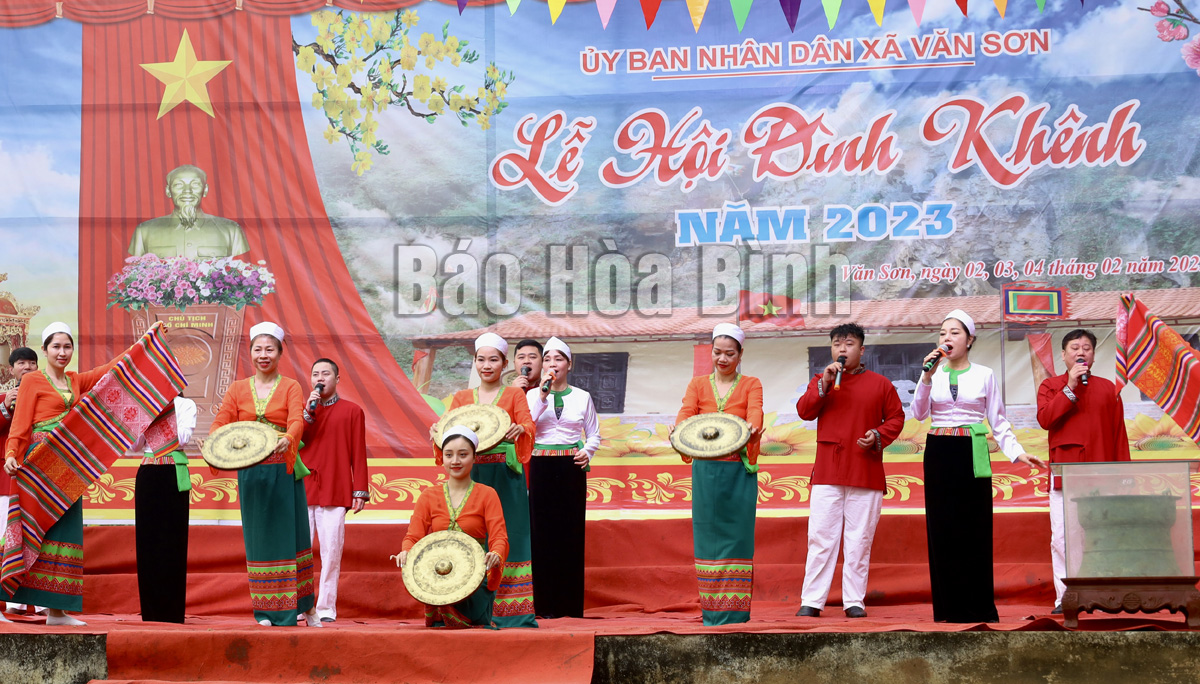
(HBO) - The authority of Lac Son district has paid heed to taking measures to exploit the unique Muong culture and untouched natural landscapes for tourism development, aiming to turn tourism into a spearhead economic sector, thus creating jobs and incomes for people and businesses, and increasing state budget revenue for the locality.
The identity
of Muong culture is spotlighted at the Khenh Communal HouseFestival 2023
in Van Son commune.
Boasting
beautiful natural landscapes
The highland communes of Ngoc Son, Ngoc Lau, and
Tu Do boast great potential for tourism development because they possess
attractive destinations.
Notably, Ngoc Son commune is home to Ba Nha
international parachuting site, which was selected by the General Department of
Sports to organise the opening ceremony of the Vietnam Paragliding Open
Championship in 2014 thanks to its ideal location and beautiful scenery. From
the top of Mount Ba Nha, visitors can enjoy a panoramic view of Vu Ban town and
centre communes of the district.
Meanwhile, Bai Bui in Ngoc Lau commune is
likened to a "green steppe" located on the Ngoc Son - Ngo Luong - Cuc
Phuong trekking route. It is suitable as a stopover for sightseeing, and
organising camping and campfire activities.
Mu waterfall in Tu Do commune is one of the most
attractive tourist destinations in the locality. Located at over 1,000 metres
above the sea level and at the start of the legendary Truong Son mountain
range, Mu waterfall is impressed by its majestic and untouched beauty, and pure
and cool water, and strong water flows. The waterfall is surrounded by an
untouched and picturesque forest landscape. Mu Waterfall is truly a
"paradise” for foreign tourists and youngsters who love motorbike tours to
explore.
Another impressive destination is Thung Hill in
Quy Hoa commune, which is known for its green forests, peaceful small villages
and amazing terraced fields.
Along Tan Lap and Mien Doi communes, Quy Hoa
boasts an extensive system of terraced fields, becoming one of the addresses
being researched and surveyed by scientists towards building a terraced field
heritage dossier in association with tourism development planning.
Lac Son also has a cool climate, hot springs and
Mountain Cot Ca, which is considered the roof of Muong Vang and covered with
fog all year round.
Canh Tang lake with a water surface area of
about 800 ha in Yen Phu commune is suitable for eco-tourism development.
Home to valuable cultural treasures
In addition to natural resources, Lac Son
district is renowned for the traditional cultural values of the Muong ethnic
people, closely associated with many famous places such as Muong Khu, Muong Vo,
Muong Khoi, Muong Vang. Over 91% of Lac Son’s population are Muong ethnic
people.
In recent years, many community-based tourism
models have been formed in Tu Do commune under the direction of ecotourism
development inassociationwith preserving cultural identity.
Traditional cultural values and customs of the
Muong people are still preserved in many villages in the district such as Muong
Vo and Muong Khoi, from traditional stilt houses, and unique costumes to the
Muong language and lifestyle, traditional crafts and cuisine.
Muong Vang is also one of the cradles of folk
singing, and other unique intangible cultures, including traditional festivals,
folk games, and ancestral worship traditions.
The district is also home to cultural and
historical tourism destinations, which become attractive to vistors.
According to Vice Chairman of the People’s
Committee of Lac Son district Bui Van Duong, Lac Son boasts potential to become
a branded tourism area.
The district needs to make more efforts to fully
tap the potential, towards further promoting tourism development and turning
tourism into a local spearhead economic sector, he said./.
Hoa Binh province is undergoing a dynamic transformation amid Vietnam’s national digital transition. Building on Poliburo’s Resolution No. 57-NQ/TW on breakthroughs in science, technology, innovation, and national digital transformation, the province has rolled out a wide range of practical action plans. A standout initiative is the "Digital Literacy for All” movement, an effort to ensure that no one is left behind in the digital era.
Hoa Binh province is undergoing a dynamic transformation in the wake of the national digital transformation movement. Building on Resolution No. 57-NQ/TW of the Politburo on breakthroughs in science, technology, innovation, and national digital transformation, the province has implemented a wide range of practical action plans. A standout initiative is the "Digital Literacy for All” movement ambitious effort to ensure that no one is left behind in the digital age.
With a spirit of unity and proactive problem-solving, the Party Committee, the government and the people of Dong Lai Commune (Tan Lac District) have made great strides in implementing the resolutions of the 24th Party Congress of the commune for the 2020 - 2025 term. Focusing on leadership and practical actions, the commune has brought the Party’s resolutions into daily life, creating strong impacts and pushing the local development forward.
Amid the nationwide push for digital transformation, young people in Hoa Binh Province are stepping up as dynamic pioneers, applying technology to enhance Youth Union operations and expand the reach of youth-led initiatives. Through creativity and adaptability, Youth Union organizations at all levels have introduced a series of practical solutions, contributing to modern governance and community development.
In recent years, An Nghia commune, located in Lac Son district, has stepped up administrative reform, focusing on improving the quality and efficiency of its single-window service unit for receiving and processing administrative procedures. These improvements have helped create favourable conditions for local residents and organisations to handle administrative procedures, contributing to the commune’s broader socio-economic development.
The Prime Minister-approved master plan to develop the multi-use value of forests ecosystems through 2030, with a vision to 2050, aims to improve the management and sustainable use of forest resources, create jobs, increase incomes, and improve the living standards of ethnic minorities, people in mountainous and remote areas, forest workers and those living near forests.



